Exploring water birth options involves understanding the necessary facility requirements, equipment needs, and safety measures to ensure a safe and comfortable experience for both mother and baby. Hospitals must provide dedicated water birth rooms and access to emergency medical services, while essential equipment includes a suitable water birth tub and monitoring devices. Implementing strict safety protocols, such as having trained professionals present and maintaining infection control, is vital for a successful water birth.
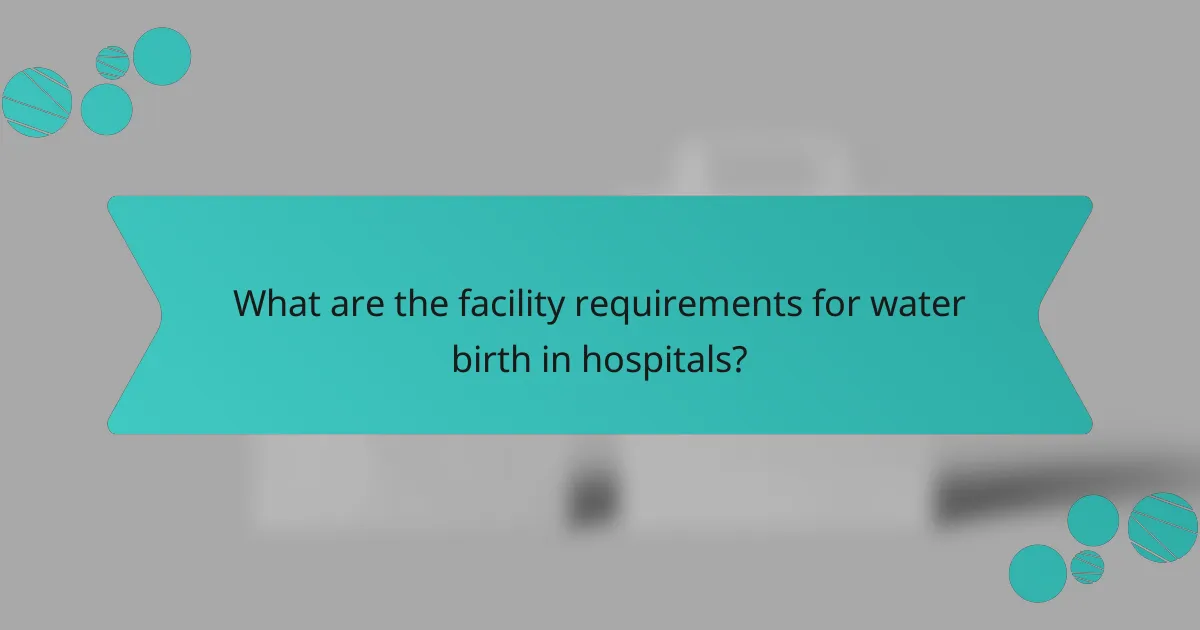
What are the facility requirements for water birth in hospitals?
Water birth in hospitals requires specific facilities to ensure safety and comfort for both the mother and baby. Key requirements include dedicated water birth rooms, access to emergency medical services, and appropriate equipment to support the birthing process.
Dedicated water birth rooms
Dedicated water birth rooms are designed specifically for the needs of women choosing to give birth in water. These rooms typically feature a spacious layout, allowing for mobility and comfort during labor. They should be equipped with a birthing tub that meets safety and hygiene standards.
These rooms often include soft lighting and calming decor to create a soothing environment. Hospitals may also provide options for music or aromatherapy to enhance the birthing experience.
Access to emergency medical services
Access to emergency medical services is crucial for water births, as unexpected complications can arise. Hospitals should have protocols in place to quickly transfer patients to surgical suites if necessary. This includes having trained staff readily available to respond to emergencies.
Additionally, the proximity of the water birth room to emergency facilities can significantly impact response times. Hospitals should ensure that emergency equipment, such as resuscitation devices, is easily accessible in the water birth area.
Privacy and comfort features
Privacy and comfort are essential for a positive water birth experience. Hospitals should provide private rooms or areas where mothers can labor without interruptions. This can include soundproofing and controlled access to ensure the mother’s space is respected.
Comfort features may include adjustable lighting, comfortable seating for partners, and options for temperature control. These elements contribute to a supportive environment that can help reduce stress during labor.
Temperature control systems
Temperature control systems are vital for maintaining the appropriate water temperature during labor. The water in the birthing tub should typically be kept between 36°C and 37°C to ensure comfort and safety for the mother and baby.
Hospitals should have reliable heating systems and thermometers to monitor water temperature continuously. This helps prevent the water from becoming too hot or cold, which can affect the labor process.
Hydraulic birthing tubs
Hydraulic birthing tubs are specifically designed for water births, offering features that enhance safety and comfort. These tubs often have adjustable heights, allowing for easier access for both the mother and healthcare providers.
Many hydraulic tubs also include built-in safety features, such as non-slip surfaces and easy drainage systems. Hospitals should ensure that these tubs are regularly maintained and cleaned to meet health standards.
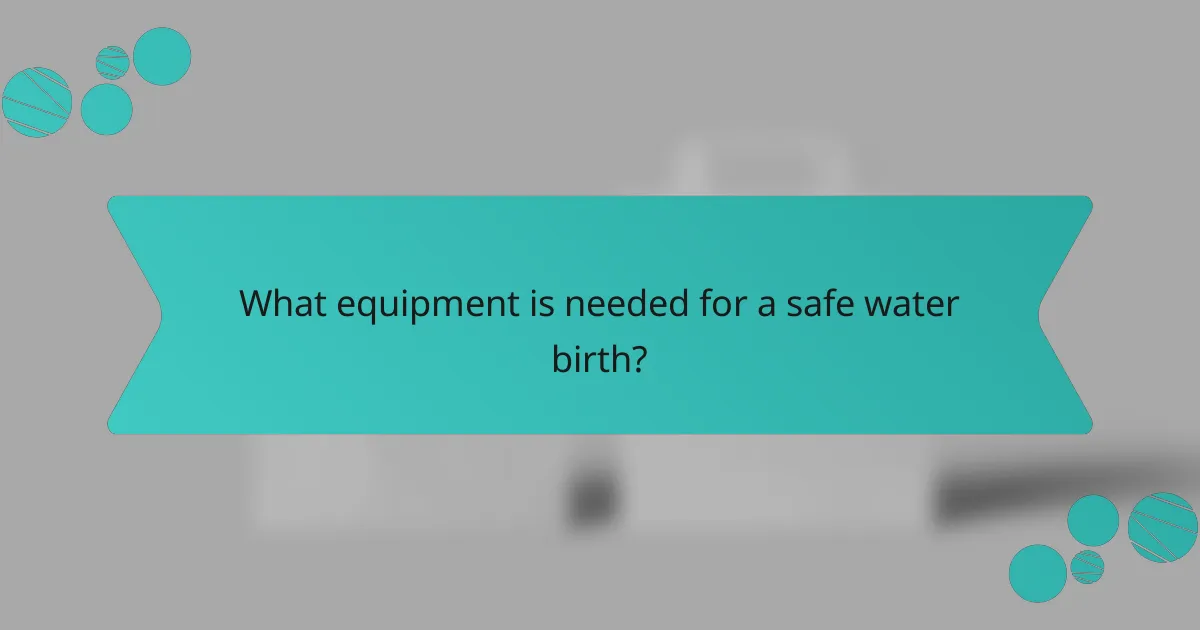
What equipment is needed for a safe water birth?
To ensure a safe water birth, specific equipment is essential. This includes a suitable water birth tub, fetal monitoring devices, temperature gauges, non-slip mats, and emergency resuscitation equipment.
Water birth tubs
A water birth tub is designed to provide a comfortable and safe environment for labor and delivery. These tubs should be spacious enough to allow for movement and should be made of materials that are easy to clean and disinfect. Look for tubs that meet safety standards and have features like a non-slip surface and a stable base.
When selecting a tub, consider options that allow for easy entry and exit, as well as those that can maintain the water temperature throughout labor. Some facilities may offer inflatable tubs, while others may have permanent installations.
Fetal monitoring devices
Fetal monitoring devices are crucial for tracking the baby’s heart rate during labor. Continuous monitoring can be achieved through wireless systems that do not restrict movement in the water. These devices help ensure that both the mother and baby remain safe throughout the birthing process.
When choosing monitoring devices, ensure they are waterproof and compatible with water birth settings. Discuss with your healthcare provider about the best options available to you.
Water temperature gauges
Maintaining the right water temperature is vital for comfort and safety during a water birth. The ideal water temperature typically ranges from 36°C to 37.5°C (97°F to 99.5°F). A reliable temperature gauge will help monitor this consistently.
Consider using digital thermometers for quick readings and ensure they are waterproof. Regularly check the water temperature to avoid overheating or cooling, which can affect labor progression.
Non-slip mats
Non-slip mats are essential for preventing slips and falls around the water birth area. These mats should be placed on the floor surrounding the tub to provide stability for the mother and support team during labor and delivery.
Choose mats that are easy to clean and made from durable materials. Ensure they have a strong grip to minimize the risk of accidents, especially in wet conditions.
Emergency resuscitation equipment
Having emergency resuscitation equipment on hand is critical for any birth setting, including water births. This equipment should include items like suction devices, oxygen masks, and resuscitation bags, all of which should be easily accessible.
Ensure that your birthing facility is equipped with the necessary emergency tools and that the staff is trained in their use. Regular checks and maintenance of this equipment can help ensure it is ready when needed.
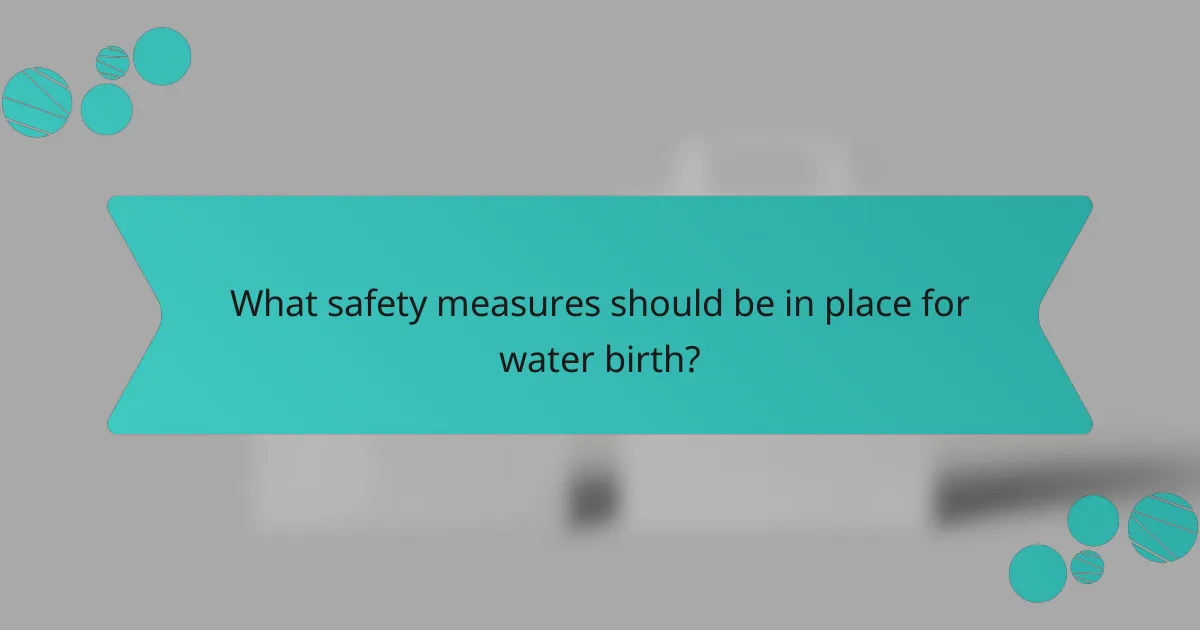
What safety measures should be in place for water birth?
Safety measures for water birth are crucial to ensure the well-being of both the mother and the baby. Key protocols include having trained healthcare professionals present, continuous monitoring during labor, strict infection control guidelines, and well-defined emergency response plans.
Trained healthcare professionals
Having trained healthcare professionals is essential for a safe water birth. This includes midwives or obstetricians who are experienced in water births and familiar with the specific protocols involved. They should be able to monitor the mother and baby effectively throughout the process.
In many regions, healthcare providers must undergo specific training related to water birth practices. This training often covers the physiological aspects of labor in water, potential complications, and how to manage them effectively.
Continuous monitoring protocols
Continuous monitoring protocols are vital to track the health of both the mother and the baby during water birth. This typically involves regular checks of the baby’s heart rate and the mother’s vital signs. Monitoring can be done using waterproof equipment designed for use in the water.
Providers may use handheld Dopplers or waterproof telemetry systems to ensure that both the mother and baby remain stable throughout labor. It’s important to establish a monitoring schedule that allows for both safety and comfort.
Guidelines for infection control
Infection control is a critical aspect of water birth safety. Facilities should adhere to strict hygiene protocols, including using clean, sterile equipment and ensuring that the birthing pool is properly sanitized before each use. Regular water quality checks are also necessary.
Healthcare providers should wash their hands thoroughly and wear gloves when necessary. Additionally, guidelines may specify the use of disposable liners for the birthing pool to minimize contamination risks.
Emergency response plans
Having a clear emergency response plan is essential for addressing any complications that may arise during water birth. This plan should outline the steps to take in case of emergencies, such as fetal distress or maternal complications.
Facilities should be equipped with necessary emergency equipment, such as resuscitation tools and medications. Regular drills and training sessions for staff can help ensure that everyone is prepared to act swiftly and effectively in an emergency situation.
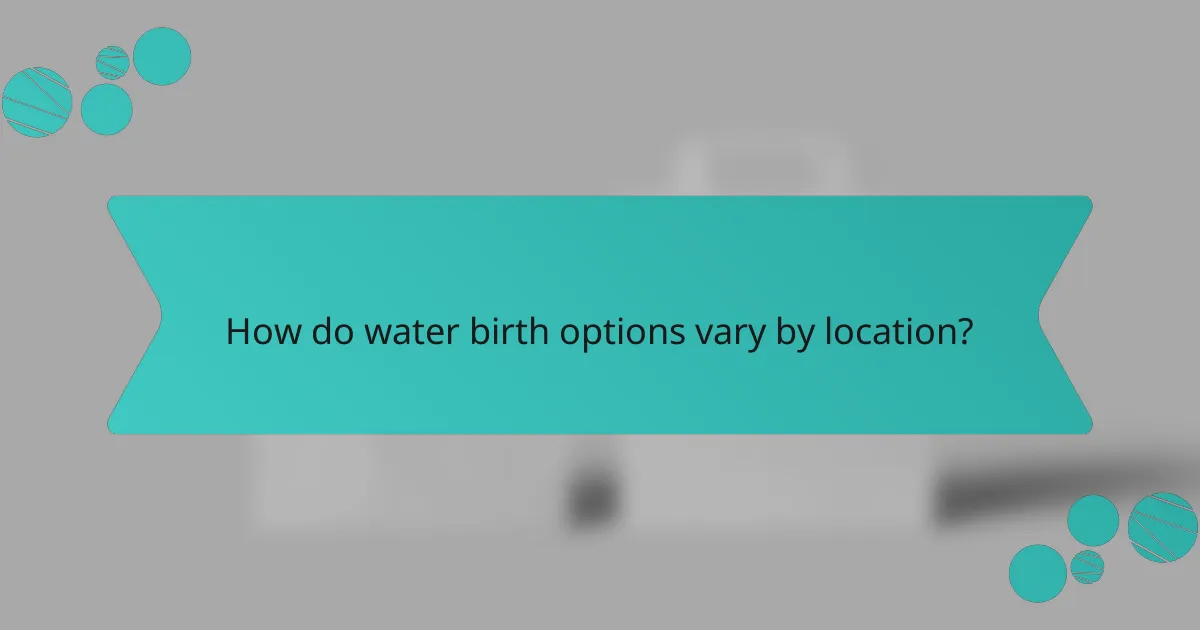
How do water birth options vary by location?
Water birth options can differ significantly based on geographic location, influenced by factors such as facility availability, state regulations, and insurance coverage. Understanding these variations is essential for expectant parents considering this birthing method.
Availability in urban vs. rural areas
Water birth facilities are generally more accessible in urban areas where hospitals and birthing centers are equipped with specialized tubs and trained staff. In contrast, rural areas may have limited options, often relying on home births or smaller clinics that might not offer water birth services.
Expectant parents in rural locations should research local midwives or home birth options, as they may provide water birth services even when hospitals do not. It’s crucial to ensure that any chosen facility or provider has the necessary equipment and safety protocols in place.
State regulations on water birth
State regulations regarding water birth can vary widely, with some states having specific guidelines for the practice in hospitals and birthing centers. Certain states may require water births to be conducted only under the supervision of licensed midwives or obstetricians, while others may have fewer restrictions.
It is important for parents to check their state’s health department website or consult with local healthcare providers to understand the legal requirements and recommendations for water births in their area.
Insurance coverage differences
Insurance coverage for water births can differ based on the provider and the location. Some insurance plans may cover water births in hospitals or accredited birthing centers, while others might not cover home births or midwife-assisted water births.
Expectant parents should contact their insurance company to clarify coverage details and any potential out-of-pocket costs associated with water birth services. It may be beneficial to compare different plans to find one that offers the best coverage for water birth options.
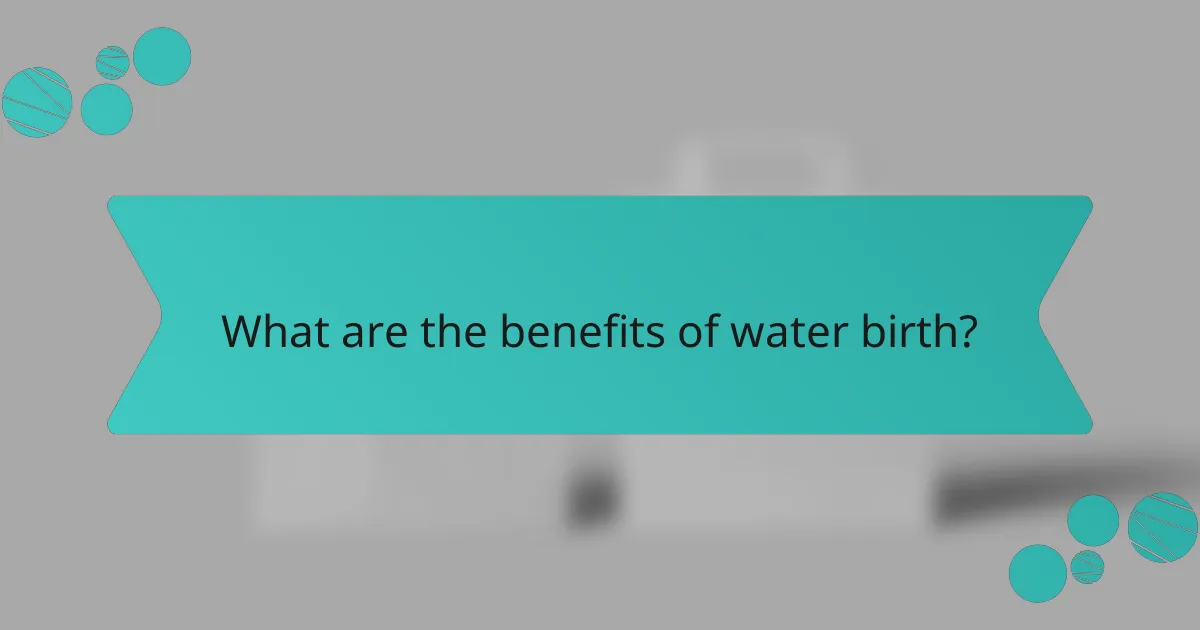
What are the benefits of water birth?
Water birth offers several advantages, including reduced pain and a more relaxed environment for labor. Many women find that immersion in warm water can help ease contractions and promote a sense of calm during the birthing process.
BODY REQUIREMENTS
To facilitate a successful water birth, specific body requirements must be met. The birthing facility should have a designated water birth pool that is large enough to allow for movement and comfort. Additionally, the water temperature should be maintained between 36°C and 37.5°C to ensure the mother’s comfort and safety.
It is essential to have trained staff available who are experienced in water births. They should be knowledgeable about the physiological aspects of labor and delivery, as well as the potential risks and benefits associated with water immersion during childbirth.
DEPTH & COVERAGE
Depth and coverage refer to the pool’s depth and the surrounding area’s safety measures. A water birth pool should ideally be at least 60 cm deep to allow for adequate immersion, which can help with pain relief. Surrounding the pool, there should be non-slip surfaces to prevent accidents when entering or exiting the water.
Consideration should also be given to the coverage of emergency equipment. Facilities should have immediate access to essential medical supplies and equipment, such as oxygen and resuscitation tools, to ensure safety during the water birth process.
